Key takeaways:
- Meal prepping enhances health, saves time, and promotes mindful eating through structured planning and preparation of meals.
- Choosing the right containers and organizing cooking efficiently are crucial for successful meal prep, leading to better food storage and a more enjoyable cooking experience.
- Personalization and flexibility in meal prepping cater to individual lifestyles, making it a sustainable practice that can adapt to varying energy levels and preferences.
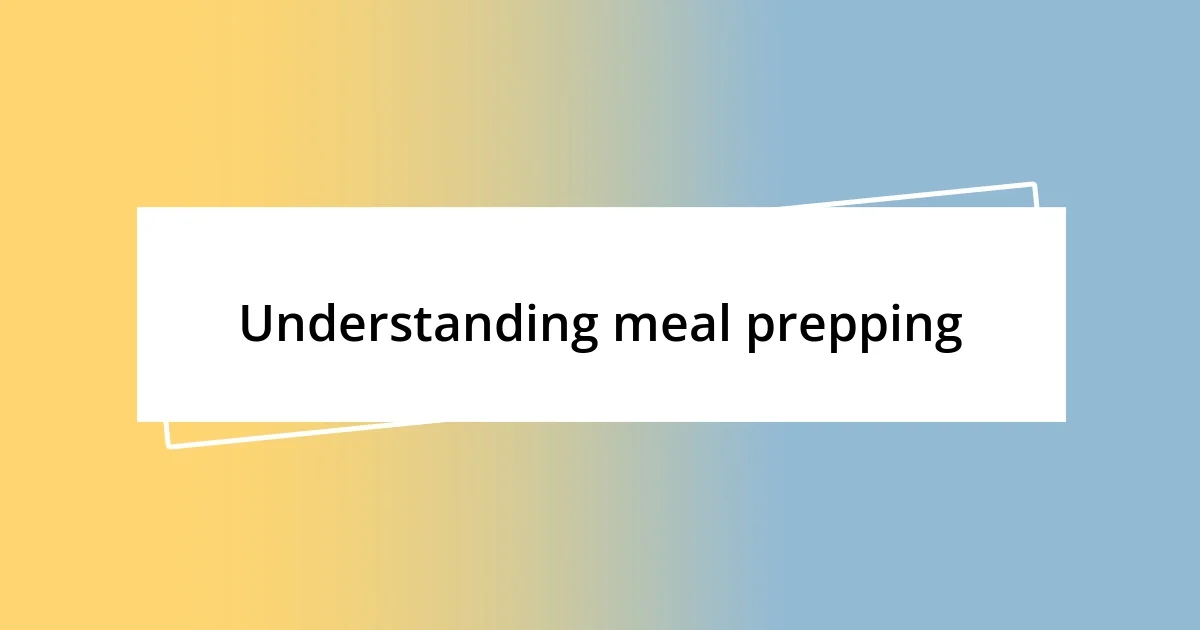
Understanding meal prepping
Meal prepping is a structured approach to planning and preparing meals ahead of time, which can significantly contribute to a healthier lifestyle. When I first started, I was overwhelmed by the idea of dedicating a whole day to cooking, but I quickly learned that the payoff in terms of time saved during the week was worth it. What could be better than knowing exactly what I’ll be eating instead of fumbling around in the kitchen each night?
In my experience, meal prepping goes beyond just cooking in bulk; it’s about creating a rhythm that fits your life. For instance, I’ve found it incredibly freeing to dedicate a few hours each Sunday to chop, cook, and package my meals into containers. I often think to myself, how much easier is it to stick to my nutrition goals when healthy meals are ready to grab and go?
Understanding the different methods of meal prepping—like batch cooking, portioning, or freezing—has been eye-opening. When I experimented with freezing individual portions, I was amazed at how easy it made weeknight dinners. It really made me wonder: don’t we all deserve those little moments of ease in our busy days?
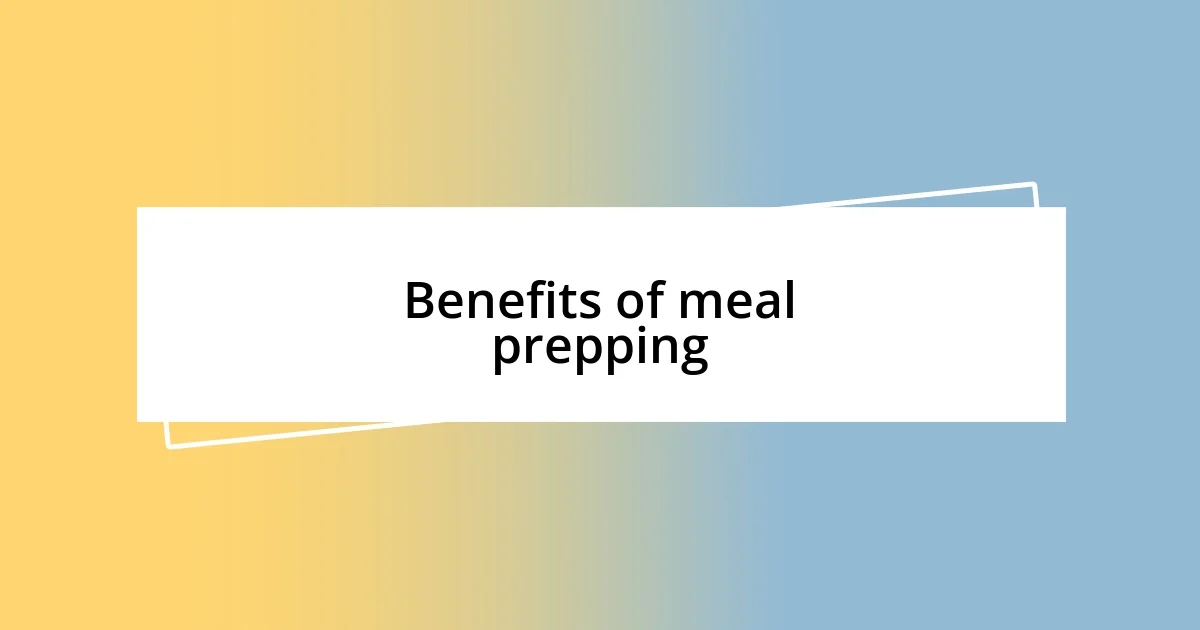
Benefits of meal prepping
Meal prepping offers a myriad of benefits that can fundamentally improve your daily routine. One of the most significant advantages is the tremendous time it saves during the week. I remember my first week of meal prepping—I spent a few hours on a Sunday afternoon chopping veggies and cooking grains, and the subsequent days felt like a breeze. With meals prepped, evenings became relaxing instead of frantic, allowing me more time to unwind.
Another benefit I’ve experienced is financial savings. By planning my meals in advance, I can shop with purpose, avoiding impulse buys. It’s surprising how much money can be saved when I focus on the ingredients I actually need rather than getting sidetracked in the store. I’ve even turned my meal prep into a little game, calculating how much I save each week—it adds a fun twist to grocery shopping!
Lastly, meal prepping nurtures mindful eating habits. Having healthy meals at the ready has helped me resist the temptation of unhealthy snacking. I often find myself feeling proud when I reach for a colorful, nutritious container instead of junk food. It’s this small shift that truly reflects how meal prepping isn’t just about food; it’s about cultivating a healthier relationship with what I eat.
| Benefit | Description |
|---|---|
| Time Savings | Allows for a more relaxed and organized week. |
| Cost Efficiency | Reduces impulse buying by enabling targeted grocery shopping. |
| Mindful Eating | Encourages healthier food choices and portion control. |

Planning your meal prep
Planning your meal prep sets the foundation for a successful week ahead. I always find it helpful to dedicate a bit of time to outline what I want to eat throughout the week. This simple step not only prevents decision fatigue but also allows me to look forward to the meals I’ve planned. For instance, I love mixing up flavors—some weeks I might focus on Mediterranean-inspired dishes; other weeks are all about comforting stews.
Here are some tips that work for me when planning:
- Choose a Theme: Picking a cuisine theme can guide your recipes and make grocery shopping easier.
- Write a Grocery List: Map out your meals and jot down the ingredients needed. I find this keeps me accountable and saves time at the store.
- Prep with Variety: I aim for a mix of proteins, veggies, and grains to keep meals exciting throughout the week.
- Use a Calendar: I put my meals on a calendar to visualize my week; it’s like a little roadmap for my meals.
- Stay Flexible: If something doesn’t go as planned, that’s okay! I’ve learned to embrace leftovers or swap meals around based on my mood.
By planning meticulously, I’ve noticed the meal prep process becomes less of a chore and more of an enjoyable ritual. Recently, I started incorporating friend’s recipes into my plan, which not only added diversity but also turned meal prepping into a bonding experience. The anticipation of trying something new not only excites my taste buds but also motivates me to stay consistent.

Choosing the right containers
Choosing the right containers can really make or break your meal prep experience. I’ve tried a variety of options, and what I’ve learned is that the best containers balance durability with ease of use. When I switched to BPA-free glass containers, I noticed how much better my food kept its flavor. Plus, I love that they hold up well in the microwave and dishwasher—no more worrying about stains or warping!
One thing I keep in mind is compartmentalization. Personally, I enjoy having separate sections for proteins, carbs, and veggies. This not only helps maintain the integrity of the flavors but also makes lunch feel more like a culinary experience rather than just another meal. Have you ever been disappointed when all your food mixed together? That’s where those divided containers come into play for me. They keep everything neat and promote a more appetizing presentation.
Lastly, I can’t stress enough the importance of size versatility. I’ve found that having a mix of large and small containers works wonders. For instance, when I prepped a hearty chili last week, I stored some in a larger container for dinner, while packing smaller portions for lunches. This flexibility saves space in my fridge and prevents waste—an aspect I find particularly rewarding. It’s all about finding what containers fit your lifestyle, and I encourage you to explore until you discover your perfect match!
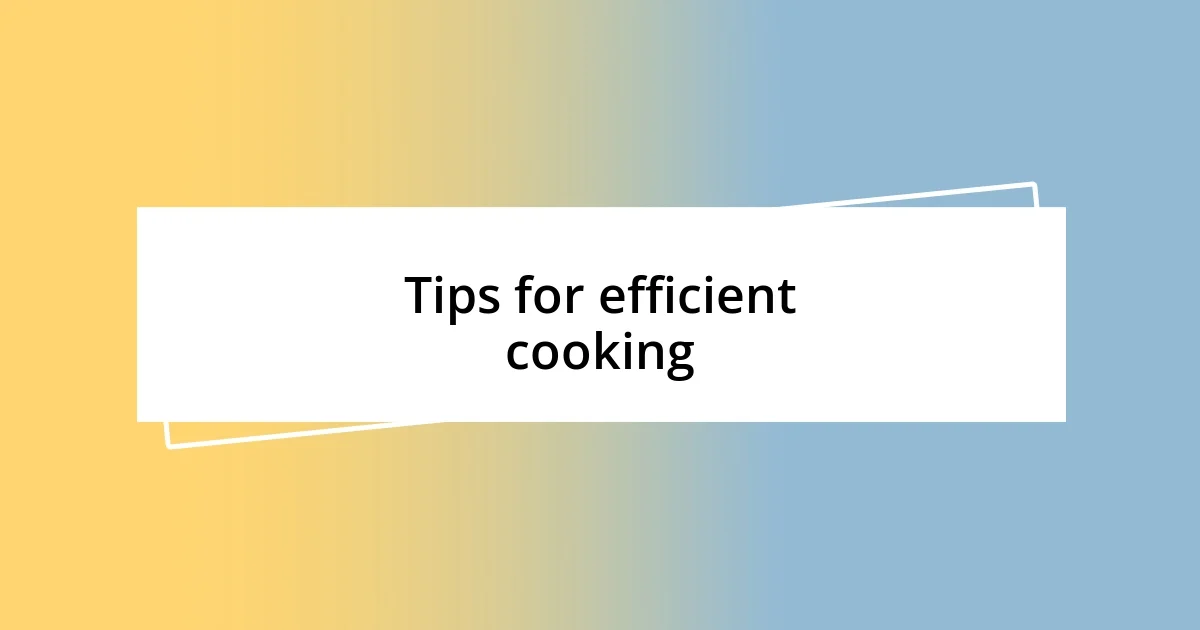
Tips for efficient cooking
One of my go-to tips for efficient cooking is to streamline the workflow in the kitchen. I’ve found that organizing ingredients and equipment beforehand significantly cuts down on time spent rummaging around. It’s always a game changer for me to lay out everything I’ll need, from spices to cutting boards. Have you ever experienced that frantic search for a tool right when you need it? That’s not how I want my cooking session to feel!
I also love to multitask while cooking; it’s like a dance of efficiency. While my grains are simmering, I chop veggies or marinate proteins. This not only maximizes productivity but also keeps me engaged in the kitchen. Just the other day, I was preparing a batch of quinoa and took that time to roast some vegetables. The overlapping actions transform the cooking process into a delightful experience, blending tasks seamlessly.
Lastly, I can’t recommend pre-chopping ingredients enough. On my busy days, I’ve found that having chopped onions, garlic, or bell peppers ready to go makes throwing together a meal effortless. I often spend a bit of time on the weekend prepping these staples, and it’s incredible how much easier my weeknight cooking becomes. It’s like setting the stage for a performance—once everything’s prepped, the main act, the meal itself, feels like a breeze. Isn’t it rewarding to see a delicious dish come together so smoothly?
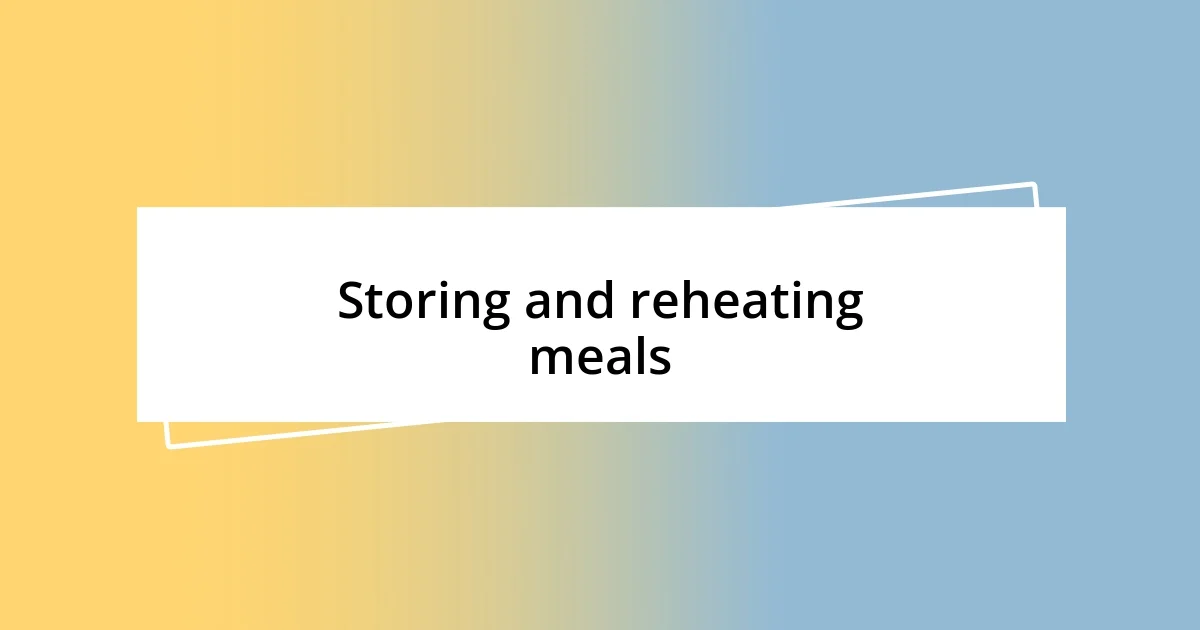
Storing and reheating meals
Storing meals properly is crucial for maintaining freshness and flavor. After a long day, I’ve realized there’s nothing worse than digging into a meal that’s lost its appeal. I often use airtight containers to ensure my food stays as delicious as the day I prepped it. Have you ever had a storage mishap that left your meal unappetizing? It’s disheartening, but choosing the right lid makes a world of difference.
When it comes to reheating, I prefer using the microwave for convenience but am always mindful of temperature. One trick I’ve adopted is to add a splash of water or cover my food with a damp paper towel. It helps to keep the moisture in and prevents that dreaded dry-out! The other day, when I reheated last week’s curry, that little tip made all the difference—it was just as flavorful as the first serving.
Finally, I find that storing meals in single-serving sizes helps manage portion control, which can be a bit of a challenge. I often pack my meals in individual containers that are easy to grab on busy mornings. This way, I feel less tempted to overindulge, and the convenience leads me to actually stick to my meal plan. It’s empowering to have healthy options ready to go, don’t you think?
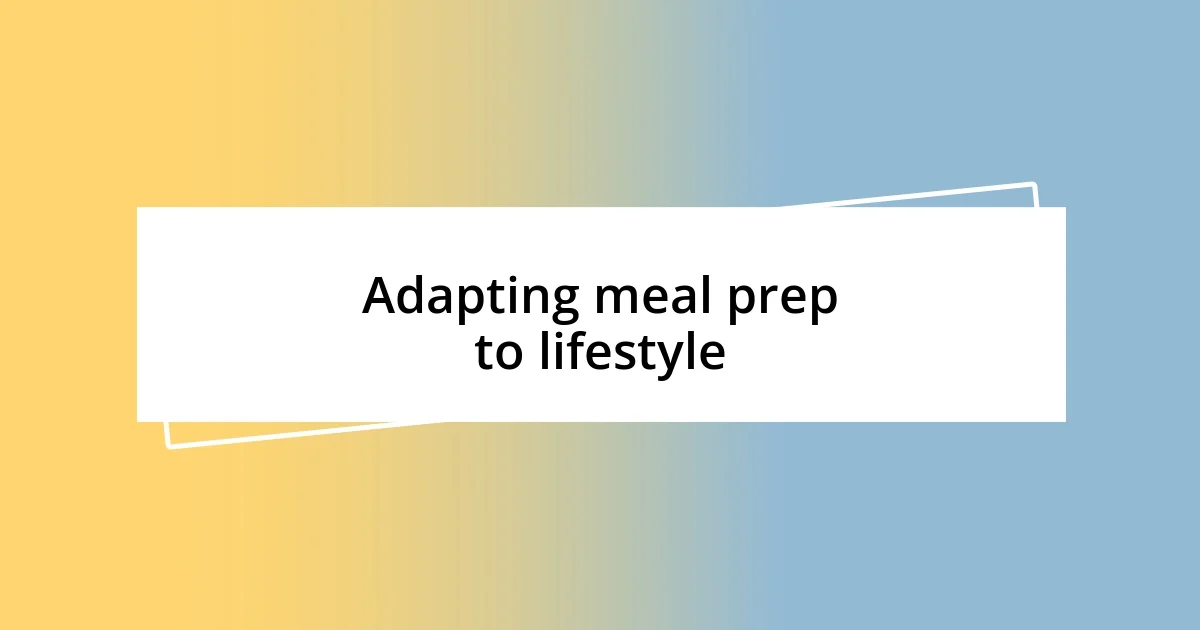
Adapting meal prep to lifestyle
Adapting meal prep to fit my lifestyle has been a game-changer for me. For example, as someone who often juggles a hectic schedule, I’ve come to appreciate the flexibility of batch cooking. On days when I know I’ll be rushing around, I spend a little extra time on the weekends preparing larger quantities of staples that can easily be mixed and matched throughout the week. Have you ever tried making a big pot of chili or a tray of roasted vegetables? It’s like setting yourself up for a week of easy meals that won’t leave you scrambling.
I’ve learned that the key to sustainability in meal prepping lies in listening to my body and my schedule. There are days when I feel like a culinary enthusiast, eager to experiment in the kitchen. But then there are also days where the thought of cooking is just too daunting. During those moments, I opt for quick and simple meals. Recently, I embraced the power of salads—throwing together a mix of greens, canned beans, and whatever leftover protein I have. It reduces stress while still keeping healthy eating in my routine. How about you? Do you adapt your meals based on your energy levels?
Finally, I’ve found that it’s all about personalization. I make sure to include meals I genuinely enjoy, ensuring I don’t get bored with my own cooking. If I know I love a certain dish, like a flavorful stir-fry, I’m more likely to stick to my meal plan. Just last week, I whipped up a large batch of my favorite lemon-garlic chicken, and it brightened my entire week. What’s that one comfort food you could eat over and over? Finding those personal favorites not only makes meal prep enjoyable but transforms it into something I look forward to, rather than a chore.












